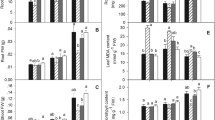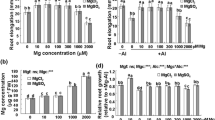Abstract
Aims
The aims of this work were to investigate the aluminum (Al) and phosphate (P) interactions in the regulation of root system architecture of Arabidopsis thaliana seedlings and the contribution of auxin signaling in primary and lateral root growth in response to Al toxicity.
Methods
Detailed analyses of root system architecture and cell division were performed in Arabidopsis WT seedlings and in low phosphorus insensitive mutants lpi1-3 and lpr1-1 lpr2-1 in response to Al. Expression studies of P-deficiency regulated phosphate transporter AtPT2 were also conducted. The role of auxin as a mediator of root morphogenetic changes by Al was evaluated by using the auxin-signaling mutants tir1, tir1 afb2 afb3, and arf7 arf19.
Results
Al inhibited primary root growth by affecting cell cycle progression and causing differentiation of cells in the root meristem. These effects were reduced in low phosphorus insensitive lpi1-3 and low phosphate resistant lpr1-1 lpr2-1 Arabidopsis mutants. Al also activated the expression of the low phosphate-induced P transporter AtPT2 in roots. Lateral root formation by Al decreased in tir1 afb2 afb3 while arf7 arf19 mutants were highly resistant to Al in both primary root inhibition and lateral root induction.
Conclusions
Our results suggest that lateral root formation in response to Al toxicity and P deficiency may involve common signaling mechanisms, while a pathway involving ARF7 and ARF19 is important for primary root growth inhibition by Al.









Similar content being viewed by others
Abbreviations
- Al:
-
Aluminum
- LR:
-
Lateral roots
- LRD:
-
Lateral root density
- NPA:
-
Naphthylphthalamic acid
- P:
-
Phosphorus
- Pi:
-
Phosphate
- PRL:
-
Primary root length
- RSA:
-
Root system architecture
- ROS:
-
Reactive oxygen species
- WT:
-
Wild-type
References
Brautigan DJ, Rengasamy P, Chittleborough DJ (2012) Aluminium speciation and phytotoxicity in alkaline soils. Plant Soil 360:187–196
Colón-Carmona A, You R, Haimovitch-Gal T, Doerner P (1999) Spatio-temporal analysis of mitotic activity with a labile cyclin-GUS fusion protein. Plant J 20:503–508
Dharmasiri N, Dharmasiri S, Estelle M (2005) The F-box protein TIR1 is an auxin receptor. Nature 435:441–445
Doncheva S, Amenós M, Poschenrieder C, Barceló J (2005) Root cell patterning–a primary target for aluminum toxicity in maize. J Exp Bot 56:1213–1220
Gaume A, Machler F, Frossard E (2001) Aluminum resistance in two cultivars of Zea mays L.: root exudation of organic acids and influence of phosphorus nutrition. Plant Soil 234:73–81
Jones DL, Gilroy S, Larsen PB, Howell SH, Kochian LV (1998) Effect of aluminum on cytoplasmic Ca2+ homeostasis in root hairs of Arabidopsis thaliana (L.). Planta 206:378–387
Karthikeyan AS, Varadarajan DK, Mukatira UT, D’Urzo MP, Damsz B, Raghothama KG (2002) Regulated expression of Arabidopsis phosphate transporter. Plant Physiol 130:221–233
Kepinski S, Leyser O (2005) The Arabidopsis F-box protein TIR1 is an auxin receptor. Nature 435:446–451
Kinraide TB (1997) Reconsidering the rhyzotoxicity of hydroxyl, sulphate, and fluoride complexes of aluminum. J Exp Bot 48:1115–1124
Kollmeier M, Felle HH, Horst WJ (2000) Genotypical differences in Al resistance of Zea mays (L.) are expressed in the distal part of the transition zone. Is reduced basipetal auxin flow involved in inhibition of root elongation by Al? Plant Physiol 122:945–956
Liao H, Wan H, Shaff J, Wang X, Yan X, Kochian L (2006) Phosphorus and aluminium interactions in soybean in relation to aluminum tolerance. Exudation of specific organic acids from different regions of the intact root system. Plant Physiol 141:674–684
López-Bucio J, Hérnandez-Abreu E, Sánchez-Calderón L, Nieto-Jacobo MF, Simpson J, Herrera-Estrella L (2002) Phosphate availability alters architecture and causes changes in hormone sensitivity in the Arabidopsis root system. Plant Physiol 192:244–256
Ma JF, Hiradate S, Nomoto K, Iwashita T, Matsumoto H (1997) Internal detoxification mechanism of Al in Hydrangea–Identification of Al form in the leaves. Plant Physiol 113:1033–1039
Ma JF, Hiradate S, Matsumoto H (1998) High aluminum resistance in buckwheat. Plant Physiol 117:753–759
Malamy JE, Benfey PN (1997) Organization and cell differentiation in lateral roots of Arabidopsis thaliana. Development 124:33–44
Maron LG, Kirst M, Chuanzao M, Milner MJ, Menossi M, Kochian LV (2008) Transcriptional profiling of aluminum toxicity and tolerance responses in maize roots. New Phytol 179:116–128
Neumann A, Horst WJ (2003) Effect of aluminium supply on aluminium uptake, translocation, and blueing of Hydrangea macrophylla (Thunb.) Ser. cultivars in a peat-clay substrate. J Hortc Sci Biotech 78:463–469
Nezames CD, Sjogren CA, Barajas JF, Larsen PB (2012) The Arabidopsis cell cycle checkpoint regulators TANMEI/ALT2 and ATR mediate the active process of aluminum-dependent root growth inhibition. Plant Cell 24:608–621
Okushima Y, Overvoorde PJ, Arima K, Alonso JM, Chan A, Chang C, Ecker JR, Hughes B, Lui A, Nguyen D, Onodera C, Quach H, Smith A, Yu G, Theologis A (2005) Functional genomic analysis of the AUXIN RESPONSE FACTOR gene family members in Arabidopsis thaliana: unique and overlapping functions of ARF7 and ARF19. Plant Cell 17:444–463
Pérez-Torres C-A, López-Bucio J, Cruz-Ramírez A, Ibarra-Laclette E, Dharmasiri S, Herrera-Estrella L (2008) Phosphate availability alters lateral root development in Arabidopsis by modulating auxin sensitivity via a mechanism involving the TIR1 auxin receptor. Plant Cell 20:3258–3272
Polle E, Konzak CF, Kittrick JA (1978) Visual detection of aluminium tolerance levels in wheat by hematoxylin staining of seedling roots. Crop Sci 18:823–827
Richards KD, Schott EJ, Sharma YK, Davis KR, Gardner RC (1998) Aluminum induces oxidative stress genes in Arabidopsis thaliana. Plant Physiol 116:409–418
Ritchie GSP (1995) Soluble aluminium in acid soils: principals and practicalities. Plant Soil 17:17–27
Rounds MA, Larsen PB (2008) Aluminum-dependent root growth inhibition in Arabidopsis results from AtATR-regulated cell cycle arrest. Curr Biol 18:1495–1500
Ruegger M, Dewey E, Gray WM, Hobbie L, Turner J, Estelle M (1998) The TIR1 protein of Arabidopsis functions in auxin response and is related to human SKP2 and yeast Grr1p. Gene Dev 12:198–207
Sánchez-Calderón L, López-Bucio J, Chacón-López A, Cruz-Ramirez A, Nieto-Jacobo F, Dubrovsky JG, Herrera-Estrella L (2005) Phosphate starvation induces a determinate developmental program in the roots of Arabidopsis thaliana. Plant Cell Physiol 46:174–184
Sánchez-Calderón L, López-Bucio J, Chacón-López A, Gutiérrez-Ortega A, Hernández-Abreu E, Herrera-Estrella L (2006) Characterization of low phosphate insensitive mutants revels a crosstalk between low phosphorus-induced determinate root development and the activation of genes involved in the adaptation of Arabidopsis to phosphorus deficiency. Plant Physiol 140:879–889
Shaff JE, Schultz BA, Craft EJ, Clark RT, Kochian LV (2010) GEOCHEM-EZ: a chemical speciation program with greater power and flexibility. Plant Soil 330:207–214
Shen H, Hou NY, Schlicht M, Wan YL, Baluška F (2008) Aluminum toxicity targets PIN2 in Arabidopsis root apices: effects on PIN2 endocytosis vesicular recycling, and polar auxin transport. Chin Sci Bull 53:2480–2487
Spence J (2001) Plant histology. In: Hawes C, Satiat-Jeunemaitre B (eds) Plant cell biology: a practical approach. Oxford University Press, New York, pp 198–206
Sun QB, Shen RF, Zhao XQ, Chen RF, Dong XY (2008) Phosphorus enhances Al resistance in Al-resistant Lespedeza bicolor but not in Al-sensitive L. cuneata under relatively high Al stress. Ann Bot 102:795–804
Sun P, Tian Q-Y, Chen J, Zhang W-H (2010) Aluminium-induced inhibition of root elongation in Arabidopsis is mediated by ethylene and auxin. J Exp Bot 61:347–356
Svitoonoff S, Creff A, Reymond M, Sigoillot-Claude C, Ricaud L, Blanchet A, Nussaume L, Desnos T (2007) Root tip contact with low phosphate media reprograms plant root architecture. Nat Genet 39:792–796
Tan K, Keltjens WG (1990) Interaction between aluminum and phosphorus in sorghum plants. I. Studies with the aluminium sensitive sorghum genotypes TAM428. Plant Soil 124:15–23
Tsugeki R, Fedoroff NV (1999) Genetic ablation of root cap cells in Arabidopsis. Proc Natl Acad Sci USA 96:12941–12946
Tyburski J, Dunajska K, Tretyn A (2009) Reactive oxygen species localization in roots of Arabidopsis thaliana seedlings grown under phosphate deficiency. Plant Growth Regul 59:27–36
von Uexküll HR, Mutert E (1995) Global extent, development and economic impact of acid soils. Plant Soil 171:1–15
Zheng SJ, Yang JL, He YF, Yu XH, Zhang L, You JF, Shen RF, Matsumoto H (2005) Immobilization of aluminum with phosphorus in roots is associated with high aluminum resistance in buckwheat. Plant Physiol 138:297–303
Acknowledgments
We thank Drs. Peter Doerner, Tom Guilfoyle, Kaschandra Raghothama, Mark Estelle and Thierry Desnos for kindly providing us with seeds of Arabidopsis transgenic and mutant lines. This work was supported by grants from the Consejo Nacional de Ciencia y Tecnología (CONACYT, México, grants Nos. 43978 and 60999), and Consejo de la Investigación Científica (UMSNH, México, grant no. CIC 2.26).
Author information
Authors and Affiliations
Corresponding author
Additional information
Responsible Editor: Yong Chao Liang.
Electronic supplementary material
Below is the link to the electronic supplementary material.

Figure S1
Arabidopsis root system architecture as affected by AlCl3 and low pH. Arabidopsis WT (Col-0), lpi1-3 and lpr1-1 lpr1-2 seedlings were grown for 12 days in medium supplemented with 125 or 150 μM AlCl3 in acidified (a–f) or neutral medium (g–l). Photographs are representative of 9 independent plates analyzed (JPEG 537 kb)

Figure S2
Root architecture in WT and lpi1-3 and lpr1-1 lpr2-1 mutants in response to Al and P. 150 μM AlCl3 (d) and/or a KH2PO4 excess (b) were supplied in the growth medium of plants. Notice that increasing P supply resumes PR growth in Al-treated seedlings (JPEG 686 kb)

Figure S3
Effect of phosphate (d–f) and aluminum (g–i) in primary root meristem in wild type and low phosphate insensitive mutants. A small increase in the concentration of phosphate restores the structure of primary root meristem in Col-0 (j) compared with control (a). Photographs are representative individuals of 45 seedlings (JPEG 633 kb)

Figure S4
Root system architecture development in WT (Col-0) and auxin related Arabidopsis mutants. Seedlings were treated with water (a), 125, 150 and 175 μM AlCl3 (b–c). Notice how double mutant arf7-1 arf19-1 is resistant to all AlCl3 concentrations tested. Photographs in a are representative of 9 independent plates analyzed (JPEG 715 kb)

Figure S5
Root waving and lateral root formation in response to aluminum in WT (Col-0) and arf7-1 arf19-1 double mutants. Note that the arf7-1 arf19-1 double mutant is not only resistant to lateral rot formation but also to primary root waving. Photographs are representative individuals of 45 seedlings (JPEG 412 kb)

Figure S6
Effect of aluminum on pH of the medium and primary root growth (a). Effect of Al on the pH of the media. b Inhibition of the primary root is similar adjusting the pH to 7.0 after addition of Al (black line) or after addition of Al (gray line) (b) in WT plants. Values shown represent the mean ± SD of 45 seedlings analyzed per treatment. Different letters are used to indicated means that differ significantly (P < 0.05) (JPEG 198 kb)
Rights and permissions
About this article
Cite this article
Ruíz-Herrera, L.F., López-Bucio, J. Aluminum induces low phosphate adaptive responses and modulates primary and lateral root growth by differentially affecting auxin signaling in Arabidopsis seedlings. Plant Soil 371, 593–609 (2013). https://doi.org/10.1007/s11104-013-1722-0
Received:
Accepted:
Published:
Issue Date:
DOI: https://doi.org/10.1007/s11104-013-1722-0




